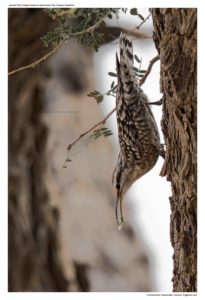Spotted Treecreeper

Indian Spotted Creeper Salpornis spilonotus
Etymology:
- Salpornis : Greek word salpinktes- wren; ornis – bird
- Spilonotus : Greek word spilos- spot; notos-backed
Vernacular Names :Guj: Rakhodithad-chad, Mar:ThipkewaliSarpika
Distribution in India: Resident in North and Central India.
Description:Size of 13–15 cm; wt. of 14 g. It has a spotted and barred plumage, long, slender, decurved bill and bark-gleaning habits, tail is slightly rounded and not used for support while climbing; flight is undulating. The nominate race in fresh plumage has forehead drab brown, crown and nape very dark brown with buff-white shaft-streaks, long, broad off-white supercilium, dark brown lores and upper ear-coverts, off-white cheeks and sides of neck, some dark brown fringes on sides of neck. The upperparts are very dark brown, feathers are tipped white, extreme tips narrowly margined brown. The lesser upperwing-coverts are pale drab-grey with dark brown subterminal bar, median and greater coverts are dark brown with white spots at tip and at base of shaft. The alula is drab brown, slightly paler at tip, primary coverts are drab brown with off-white fringes at tip and a white notch centrally on outer web. The flight-feathers are dark brown, tertials with off-white notches along fringe of outer web and white tips, secondaries and primaries are similar but white tips much reduced on primaries. The tail is dark brown, boldly barred white, central pair of rectrices with extensive pale drab-grey areas along shaft and at tip. The chin and throat are white, poorly demarcated from underparts. The iris is dark brown; bill is blackish-horn or brownish-horn, lower mandible and cutting edge of upper mandible are flesh-coloured or pale horn; legs are greyish or purplish-grey to blue-black. Both the sexes are similar. The juvenile is as adult, but notches and spots on wings are tinged buff, primaries and secondaries are broadly fringed off-white at tip, throat and upper breast are finely scaled or streaked darker.
Habitat: It is found in fairly open deciduous forest of acacia, teak etc., also in well-wooded country and mango groves.
Food habits: It eats insects, including moths and caterpillars, beetles and bugs and spiders. It forages on trunks and larger branches of trees, starting near base and working upwards, then moving to base of next tree; may also search horizontal branches. It holds the tail away from bark as it moves, thus resembling a nuthatch, and may cling to branches upside-down. It sometimes forms small flocks in non-breeding season.
Breeding habits: They breed inFeb–Jun in India. The nest is a neat, deep cup constructed from flower and leaf stalks, rootlets and bark chips, cemented on outside with spider webs, insect cocoons, caterpillar excreta and vegetable down, covered with lichen, and lined with spider webs and egg sacs, cocoons and plant down, placed above ground. They lay a clutch of 1–3 eggs. The incubation is done by both sexes. The chicks are brooded and fed by both parents.